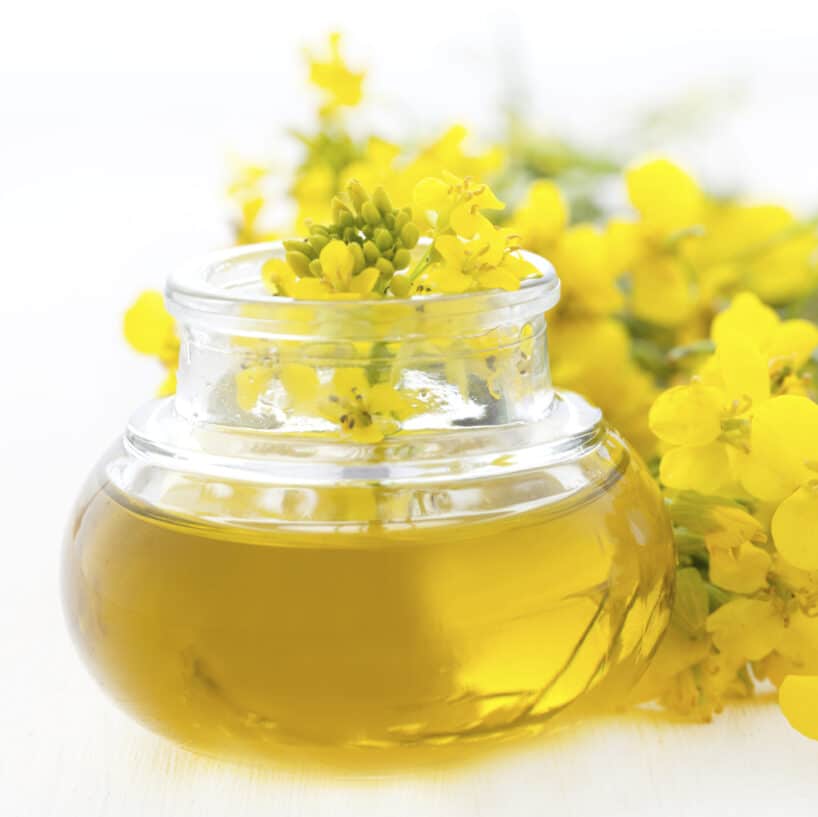Canola oil

To obtain one litre of canola oil, about 2.3 kilograms of canola are needed. Among other things, canola oil is used in cooking, as it is perfect for frying or for salad dressings due to its fine nutty taste. Thanks to its special fatty acid distribution, rapeseed oil is now considered the healthiest cooking oil. It consists of about 50 to 60 percent monounsaturated and about 30 percent polyunsaturated fatty acids.
Thus, the ratio of omega-6 to omega-3 fatty acids is 2:1, which is considered ideal for us humans. The content of essential fatty acids in this oil is several times higher than in olive oil, for example. In this context, the high proportion of alpha-linolenic acid is particularly noteworthy. The enormous content of carotenoids and vitamin E is also remarkable.
But the oil also has many uses outside the kitchen. It is used as biofuel, in technical applications and even as lamp oil. In addition, it is also becoming increasingly important in cosmetics. And for good reason.
Canola oil in cosmetics
Vitamins E and K, provitamin A (i.e., carotenoids/beta-carotene), lecithin and the already mentioned perfect fatty acid profile: oil from canola has a lot to offer for cosmetic applications. Vitamin E and provitamin A protect the skin from dangerous free radicals and thus from premature skin ageing; in addition, vitamin E keeps the skin supple and soft. Lecithin is known for a particularly refatting effect and contributes to an optimal moisture balance. Canola oil can be used in cosmetic formulations for skin, hair and nails and is used, among other things, in soaps, hair treatments, peelings, hand and nail oils and massage oils.
Sinapic acid – the active ingredient in rapeseed oil
However, it is not only the vitamins and fatty acids that give canola oil its special significance in cosmetics. The seeds of the plant also contain a lot of sinapic acid. It belongs to the phenolic acids, is a cinnamic acid derivative and forms crystallisable salts with bases that decompose on contact with air. In nature, sinapic acid is primarily found in canola.
The proportion of phenolic acids as a whole is much higher in canola meal than in comparable plants. In canola, for example, it is around 640 milligrams per 100 grams, whereas in peanuts, for example, it is only around 64 milligrams. Up to 85 percent of the phenolic acids in canola are sinapic acid or its esters. But what is so special about sinapic acid in canola oil?
Put simply, the acid in the seeds ensures that the plant does not get sunburnt. Canola plants thus produce their own sun cream, so to speak, in the form of sinapic acid esters, which are then channeled into the outermost layers of the leaves. In this way, the plant prevents the short-wave UV-B radiation from penetrating to the depths, where it would damage the DNA. The effect has already been proven: Researchers isolated the protective molecules in the laboratory and then bombarded them with UV-B rays. The result: the molecules were able to absorb the harmful rays like a natural sunscreen.
Thus, the cinnamic acid derivatives in canola oil serve as organic UV filters, which is very interesting for cosmetics production.
Fact Sheet Canola Oil
INCI: Brassica Campestris Oleifera Oil
Definition: semi-drying and medium spreading oil
Colour: pale yellow to amber
Odour: almost odourless
Iodine value: 107
Composition:
alpha-Linolenic acid: 9.2 per cent
Linoleic acid: 15 to 30 percent
Palmitic acid: 4.7 percent
Stearic acid: 1.6 percent
Oleic acid: 51 to 70 percent
Vitamin E: 55 milligrams/100 millilitres
Vitamin K
Provitamin A
Carotenoic acid
Fact Sheet Sinapic Acid
CAS number: 530-59-6
Melting point: 202 degrees Celsius
Solubility: sparingly soluble in water, highly soluble in methanol and ethanol
Recipes with canola oil from Cosmacon
Thanks to its many valuable ingredients, canola oil is an ideal ingredient for high-quality natural cosmetic products. Such products are particularly suitable for people with very dry, flaky, or chapped skin. Canola oil keeps the skin supple, supports the moisture balance, protects against free radicals and also contains an effective organic UV-B filter in the form of sinapic acid. Canola oil is used in many skin care oils, but also increasingly in natural soaps and peelings. On request, Cosmacon will be happy to develop modern and high-quality cosmetic products with rapeseed oil for you.
If you would like to have your own cosmetics made with this great lipid, you have to find the right partner.
Please do not hesitate to contact us.
Literature:
Steryl Sinapate as a New Antioxidant to Improve Rapeseed Oil Quality during Accelerated Shelf Life.
Rabiej-Kozioł D, Krzemiński MP, Szydłowska-Czerniak A.Materials (Basel). 2021 Jun 4;14(11):3092
Poljšak N, Kočevar Glavač N.Front Pharmacol. 2022 Apr 25;13:868461.